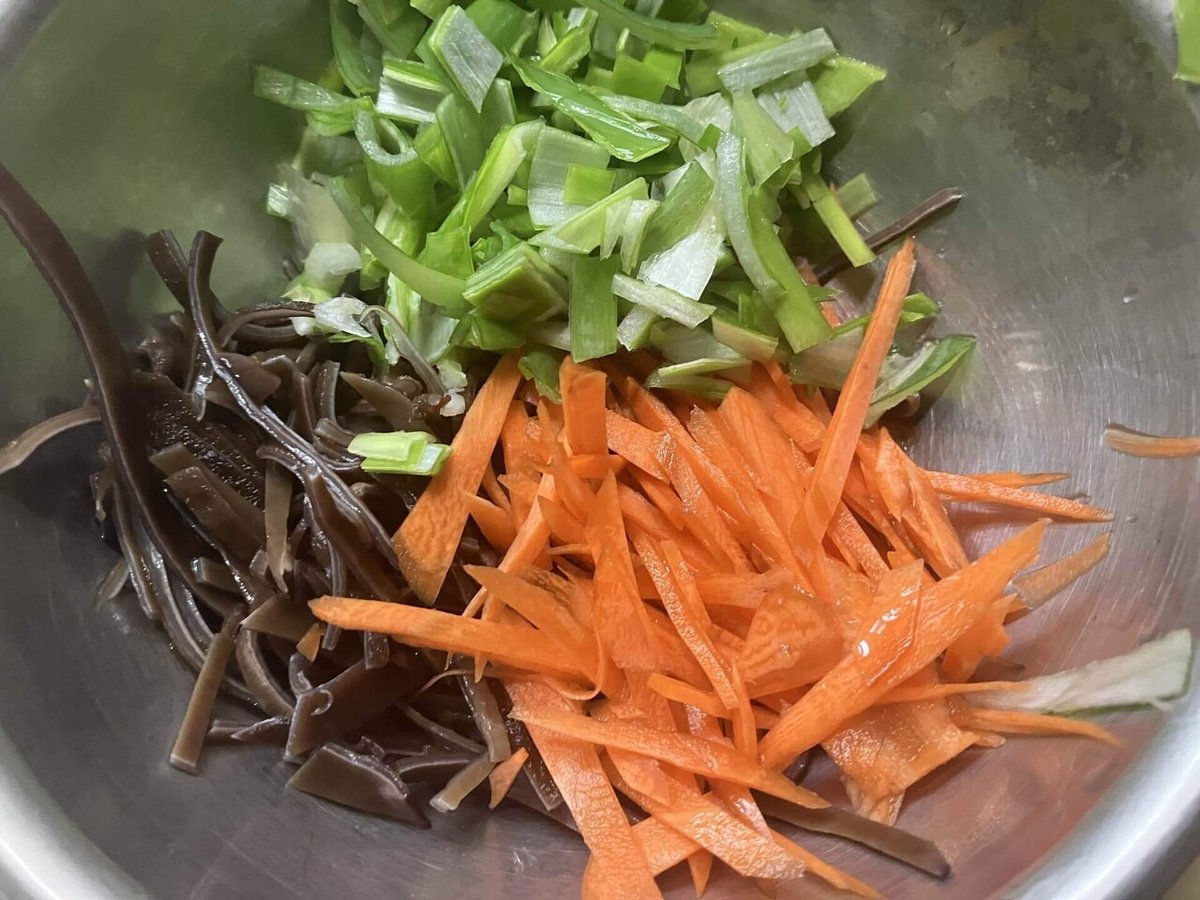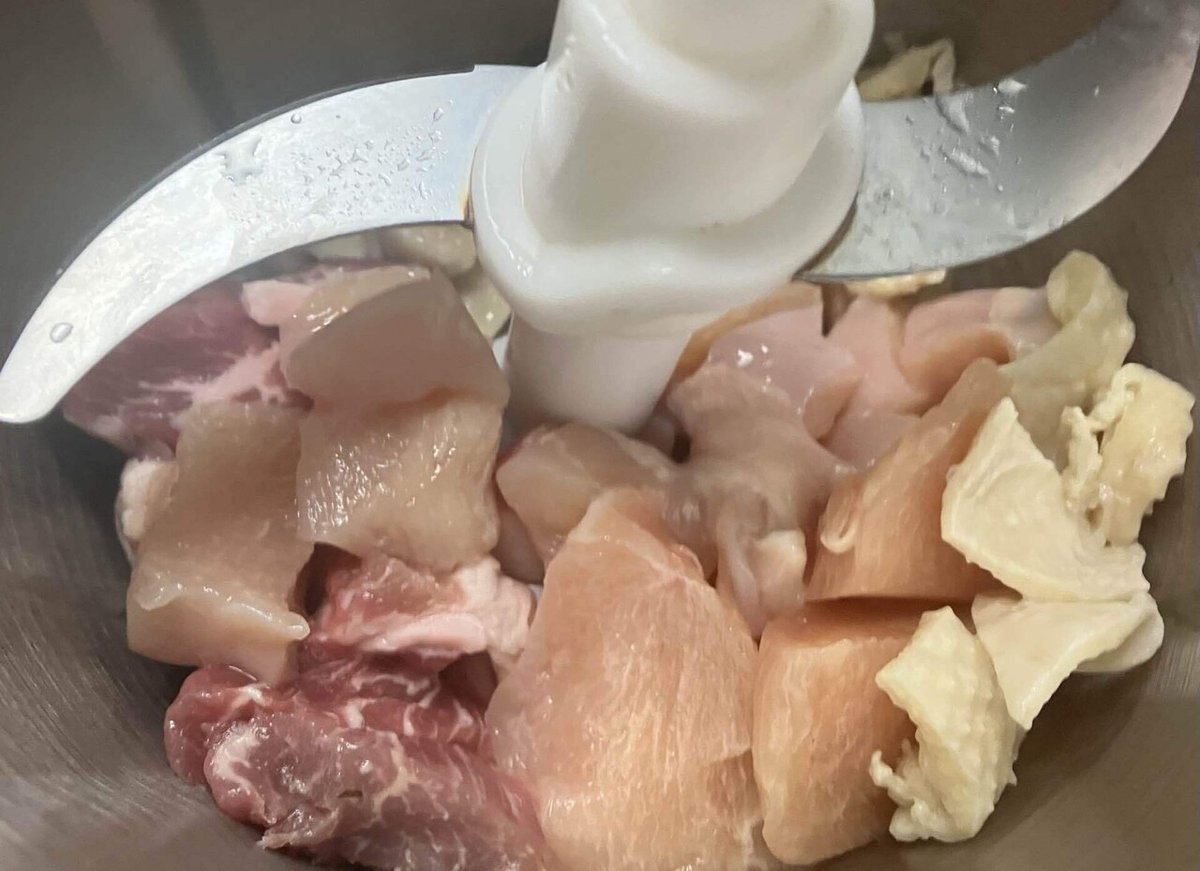
名残の苦瓜で作るお母さんのベトナム料理「カインコークア(Canh Khổ Qua)」 "Canh Khổ Qua" is a Vietnamese soup made by mom with bitter melon harvested last of the year :おまかせ小品集 Chef's choice dishes collection
深夜食堂(ドラマの深夜食堂よりずっと前のお話)」でお出しした料理の小品集。材料がある限り何でも出してました。ほとんど即興だったので何百種類も作りましたが、お客様のエピソードを思い出せるものを少しづつ再現します(差し支えある話は多少脚色しています)。
A collection of small dishes served on "Midnight Diner" (a story that took place long before the TV drama "Midnight Diner"). We served anything as long as we had the ingredients. Since it was mostly improvisation, we made hundreds of dishes, but we will recreate little by little the ones that remind us of our customers' episodes (we have dramatized some of the more inappropriate stories).
おまかせの時間
The inspiration for the recipe
僕のお客さんというか、だいぶ年下の仕事仲間の一人にベトナム人の女性がいた。仕事仲間と言っても料理の世界では無く、僕のもう一つの仕事であるコンピューターエンジニアの仲間だ。
One of my customers at the bar, or rather, one of my work colleagues who was much younger than me, was a Vietnamese woman. I don't mean a work colleague in the culinary world, but a colleague in my other job as a computer engineer.
実はここ十年くらいの間に日本のIT業界ではベトナムの存在感が高まっている。なぜかというと、少子化による日本の人材不足は、肉体労働者の世界だけでなく、エンジニアリングの分野にも及んでいるからだ。コンピューターの仕事にはホワイトカラーの仕事というイメージがあるけど、そういう仕事は10パーセント程度で、実態は90パーセントのいわゆる「頭脳のブルーワーカー」が支えている。残業に次ぐ残業を繰り返して、お決まりのプログラミングパターンをキーボードで打ち込んで、システムがちゃんと動くまで何度もテストを重ねながら、納期までにシステムがまともに動くように端末に張り付いて作業する労働者だ。それでも、コンピューターのシステムが高価だった頃は随分と単価の良い仕事だった。しかし、スマホを通してコンピューターを誰もが利用する現代では、下層の作業者は肉体労働とさして変わらない単価で働いている。コスト削減の手立てとして、この部分を外注に丸投げすることも行われて来た。4次、5次下請けというのも珍しくない。さらには外注先を海外に求めることになる。人件費が安いからだ。海外への外注を「オフショア」と呼ぶ。昔からオフショア先として中国とインドの存在感が大きかったが、最近急に外注先として台頭して来たのがベトナムだ。
インドでは普通に英語が通じるし米国流のIT手法が普及している。だから米国からのオフショア先としては最適な国となる。その利点が日本の外注先としては欠点になる場合がある。日本人は英語が苦手だし、阿吽の呼吸を要求するからだ。言外のニュアンスの理解や、独特の日本的なマネジメントを外注先に要求することが多い。その意味では文化の近い中国も良い外注先だったのだが、最近は労賃の値上がりが著しく、情報漏洩の問題もあって、ベトナムへのシフトが進んでいる。インド人や中国人ほど自分を主張しないので、日本人とはとても相性が良いようだ。日本語学習熱も高く、日本的なコミュニケーションを理解してくれる人も多い。そんな背景があって、ここ十年くらいはIT業界ではベトナム人と一緒に仕事をする場面が随分と増えた。
In fact, Vietnam has been gaining a strong presence in the Japanese IT industry over the past decade. The reason is that Japan's labor shortage caused by the declining birthrate is not only affecting the world of manual laborers, but also the field of engineering. There is an image of computer work as white-collar work, but this is only about 10 percent of the work, and in reality, 90 percent of the work is supported by so-called "blue-collar workers." These workers work overtime after overtime, typing in routine programming patterns, and repeatedly testing the system until it works properly, so that the system works properly by the deadline. Even so, when computer systems were expensive, this was a job with a very good unit price. However, in today's world where everyone uses computers through smartphones, lower-level workers work for a unit price not much different from manual labor. As a means of reducing costs, this part has been outsourced. It is not uncommon to have fourth- or fifth-tier subcontractors. Furthermore, they will look for outsourced companies overseas. This is because labor costs are low. Outsourcing to overseas is called "offshore." China and India have long been major offshore destinations, but recently Vietnam has suddenly emerged as a major outsourcing destination.
In India, English is widely spoken and American IT methods are widespread. This makes India an ideal offshore destination for the US. However, this advantage can sometimes be a disadvantage for Japanese outsourcing. This is because Japanese people are not good at English and expect a tacit understanding. They often ask their outsourcing partners to understand the nuances of what is being said and to have a unique Japanese-style management. In that sense, China, which has a similar culture, was also a good outsourcing partner, but recently, there has been a significant increase in labor costs and there has been a problem with information leaks, so there has been a shift to Vietnam. They are not as assertive as Indians or Chinese, so they seem to get along very well with Japanese people. They are also very enthusiastic about learning Japanese, and many people understand Japanese-style communication. With this background, over the past decade or so, there have been many opportunities to work with Vietnamese people in the IT industry.
彼女はとても優秀なエンジニアで、日本に出張して日本の現場とベトナムの現場のエンジニアの間を橋渡しをする仕事に就いていた。彼女は日本が大好きで、日本の男性と知り合い、日本に永住する道を選んだ。その男性を酒の席で紹介したのが僕だったので、僕が夜引き受けていたバーに二人揃ってよく遊びに来てくれた。
夏が終わりだいぶ涼しくなった頃に、彼女が訪ねて来て、僕に結婚の報告をしてくれた。その時お客さんが持ち込んできた夏の最後の収穫の苦瓜が積んであったのを見るなり、彼女は目を輝かせて「マスター、カインコークアを作ってよ。もう二年も帰京してなくて。恋しくなちゃった!」と、料理をお任せで作るリクエストを頂いたのだった。彼女はお酒が好きだったので、僕らプロジェクトのお酒好きの仲間はつるんで、仕事の跳ねた後、僕の知り合いのベトナム料理屋に行って色んな料理を食べた。その時に、僕がベトナム料理好きなのを覚えてくれていたらしい。
南ベトナム出身の人はこの苦瓜が主役の料理にお袋の味を感じる人が多い。お母さんが、家族の健康を願って、お正月などの節目に作るご馳走だからだ。ただ、ベトナムの子供も苦瓜の苦味が駄目な子が多いようだけど、大人になるにつれて忘れられない家庭の味になっていくらしい。苦瓜は体を冷やす食材だけど、このレシピは、体の温まる漢方的な食養生の具材をたっぷり合わせて、滋養強壮に効くように仕立てる。栄養いっぱいで家族ぐるみで食べるご馳走なのだ。
She was a very talented engineer and was working as a bridge between engineers in Japan and Vietnam on business trips to Japan. She loved Japan, met a Japanese man, and chose to live in Japan permanently. I was the one who introduced him to her over drinks, so the two of them often came to the bar where I was working at night.
When the summer ended and it got cooler, she came to visit me and told me about her marriage. At that time, she saw a pile of bitter melons, the last harvest of the summer, brought by a customer, and as soon as she saw them, her eyes lit up and she said, "Master, please make me some kanh kou cua. I haven't been back to Tokyo for two years. I miss it!" She made me a request to make a dish of her own. She liked alcohol, so we, the other alcohol-loving friends from the project, would hang out and go to a Vietnamese restaurant I know after work and eat a variety of dishes. It seems that she remembered that I liked Vietnamese food at that time.
Many people from southern Vietnam feel that bitter melon is the main ingredient in their dishes. This is because it is a treat that mothers make at important times such as New Year's Day, praying for the health of their family. However, it seems that many Vietnamese children also don't like the bitter taste of bitter melon, but as they grow up, it becomes an unforgettable taste of home. Bitter melon is a food that cools the body, but this recipe combines plenty of traditional Chinese herbal ingredients that warm the body, making it a nutritious and invigorating dish that the whole family can enjoy.
ベトナム料理は、お隣のタイに比べると、中国の朝貢国だった時代が長く、インド料理よりも中国料理の影響が大きい。食養生という考え方が根底に流れていて、「カイン(スープ)」の味わいは深く豊かで、辛くなくてあっさりした味わいながらも、素材の深い滋味が感じられる。日本でも人気のフォーのスープを思い浮かべてもらうと良いだろう。日本では、おひたしだったり、炒め物だったり、苦瓜の歯触りや苦味を直線的に楽しむ料理が主流だけど、東南アジアや南アジアでは、柔らかく煮込んで、苦瓜の持つ深い滋味を引き出す料理が多い。このベトナム料理も、苦瓜を、肉や様々な詰め物野菜と一緒に柔らかくとろけるように煮込んで、苦瓜の深い滋味を引き出している。直線的な苦味が旨味のハーモニーに溶け込んでいき、より柔らかく深い苦味へと昇華する。弱った身体を癒してくれる味だ。これは、北方文化の影響を受ける前の南中国の薬膳スープにも通づるものがある。現政権がナショナリズム醸成のために漢字の表記(日本の漢字仮名まじり文のような表記法)を公式には廃止してしまったが、ベトナムは日本や朝鮮半島と同じ漢文文化圏に属し、語彙の70パーセント近くは漢字で表記ができる(日本の音読みにあたる語彙は漢語起源)。「Khổ Qua」も「苦瓜」の広東語に近い発音の音読みだ。「Qua」には「瓜」以外にも「過」という漢字を当てることもできる。「苦過」と書けば日本人にも理解できるが、苦難が過ぎるという意味に読み替えることができる。今は苦しくても、時が経てば幸せになれるよ、というお母さんの子供に対する生活の教えでもあるのだ。
南の国の人は概してこういう現状に逆らわない生き方の知恵を身につけている。琉球もフィリピンもベトナムも大国に散々蹂躙されて来た国だ。ベトナムは何度も支配者が代わり、米国とソ連の代理戦争の舞台にもなってしまった。でもいつかその困難は過ぎる。そう考えないと未来を描けなかった民族の知恵なのだと思う。
Vietnamese cuisine has been a tributary state of China for a long time compared to its neighbor Thailand, and is more influenced by Chinese cuisine than Indian cuisine. The idea of dietary therapy runs deep in the cuisine, and the taste of "Khanh (soup)" is deep and rich, and while it is not spicy and has a light taste, you can feel the deep flavor of the ingredients. It would be good to imagine the soup of pho, which is also popular in Japan. In Japan, the mainstream cuisine is to enjoy the texture and bitterness of bitter melon in a straightforward way, such as boiled or stir-fried, but in Southeast Asia and South Asia, there are many dishes that stew bitter melon until it is soft and brings out its deep flavor. This Vietnamese cuisine also brings out the deep flavor of bitter melon by stewing it with meat and various stuffed vegetables until it is soft and melts. The straightforward bitterness blends into a harmony of umami and is sublimated into a softer and deeper bitterness. It is a taste that heals a weakened body. This is also similar to the medicinal soup of southern China before it was influenced by northern culture.
The current government has officially abolished the use of Chinese characters (a Japanese writing system that uses a mixture of Chinese characters and kana) in order to foster nationalism, but Vietnam belongs to the Chinese writing culture sphere, just like Japan and the Korean peninsula, and nearly 70 percent of the vocabulary can be written in Chinese characters (the Japanese on-readings are of Chinese origin). "Khổ Qua" is also an on-reading with a pronunciation close to the Cantonese pronunciation of "kugua". "Qua" can also be written as "苦(hardships)" or "過(pass)" with kanji. If written as "苦過(current hardship will be passed in future)", Japanese people can understand it, but it can also be read as meaning that hardships will pass. It is also a life lesson for mothers to their children, that even if they are suffering now, they will be happy as time passes.
People in southern countries generally have acquired the wisdom of living in this way without rebelling. The Ryukyu Islands, the Philippines, and Vietnam are all countries that have been trampled on by great powers. Vietnam has changed rulers many times and has even become a stage for proxy wars between the United States and the Soviet Union. But one day those hardships will pass. I think this is the wisdom of a people who could not envision the future without thinking in this way.
件の彼女はその後二人の子供を授かった。ただ残念ながら、彼女の結婚生活自体は長く続かず、数年後、子供をつれてベトナムに帰って行った。今はベトナム人と再婚して、大手のシステム会社で、中堅のエンジニアとして活躍している。彼女にも苦難の時があったけれど、いつか過ぎ去って幸せがまた訪れるのだ。お母さんにレシピを教わって、カインコークアで子供を育てているという、便りが届いた。こうして生活の知恵は母親から娘に伝わっていくのだろう。
The woman in question later had two children. Unfortunately, her marriage did not last long, and after a few years, she returned to Vietnam with her children. She has now remarried a Vietnamese man and is working as a mid-level engineer at a major systems company. She has also had her share of hardships, but they will pass and happiness will return. I received news that she learned the recipe for Khanh Ko Kua from her mother and is raising her children on it. In this way, the wisdom of life is passed down from mother to daughter.
Today's Ingredients:
今日の素材:
苦瓜
鶏手羽元(鶏ひき肉でも良い)
豚肩ロース(豚ひき肉でも良い)
人参
長ネギ
キクラゲ
卵
生姜
片栗粉
オイスターソース
ニョクマム(ナムプラーなど他の魚醤でも良い)
胡麻油
自然塩
胡椒
Bitter melon
Chicken wings (you can also use ground chicken)
Pork shoulder (you can also use ground pork)
Carrots, green onions
Wood ear mushrooms
Eggs
Ginger
Potato starch
Oyster sauce
Nuoc mam (you can also use other fish sauces such as nam pla)
Sesame oil
Natural salt
Pepper
procedure:
つくり方:
キクラゲを水で戻しておく。
鶏手羽元から肉を外し、さらに皮も外す。皮は茹でておく。
手羽元の骨に水を注ぎ、十五分ほど煮てスープをとる。
人参、長ネギ、キクラゲを千切りにしておく。
苦瓜の両端を切り落とし、切れ込みを入れ、箸などでワタを外しておく。
手羽元から外した肉、皮、豚肩ロースを適当な大きさに切り分けて、フードプロセッサーに入れる。
卵、片栗粉、おろし生姜、ナムプラー、オイスターソースも入れ、塩胡椒して、フードプロセッサーを回して、滑らかなミンチを作る。柔らか過ぎるようなら、片栗粉で調節する。
野菜類を入れ、よく混ぜる。
苦瓜の内側に片栗粉を振り、ミンチの肉を詰める。収まりが悪いようなら、干瓢や凧糸などで縛っても良い。
厚手の鍋に、ミンチを詰めた苦瓜を置いて、鶏のスープを注ぎ、苦瓜に透明感が出てくるまで、落とし蓋をして弱火で煮込む。
仕上げの味は塩とニョクマムで調節し、スープごと盛り付けてサービスする。
食べる時に柑橘類を絞っても良い。
Soak the wood ear mushrooms in water.
Remove the meat from the chicken wings and also the skin. Boil the skin.
Pour water over the wing bones and boil for about 15 minutes to make the soup.
Shred the carrots, spring onions and wood ear mushrooms.
Cut off both ends of the bitter melon, make a slit in it and remove the seeds and flesh with chopsticks.
Cut the meat removed from the wings, skin and pork shoulder into bite-sized pieces and put into a food processor.
Add the eggs, grated ginger, potato starch, nam pla and oyster sauce, season with salt and pepper, and run the food processor to make a smooth mince. If it's too soft, adjust the texture with potato starch.
Add the vegetables and mix well.
Sprinkle potato starch inside the bitter melon and stuff it with the minced meat. If it's difficult to pack, you can tie it up with dried gourd or kite string.
Place the bitter melon stuffed with minced meat in a thick-bottomed pot, pour in chicken broth, cover with cooking paper and simmer over low heat until the bitter melon becomes translucent.
Add salt and nuoc mam to finish, then plate and serve the soup.
You can also squeeze some citrus fruit over the dish when serving.











ヒントとバリエーション
Recipe tips and variation
ここでは手羽元の骨ででスープを取っているけれど、もちろん別途ちゃんとチキンストックを取っても良いし、市販のチキンスープを使っても良い。またフードプロセッサーを使わず、ひき肉を使っても良い。
鶏肉だけ、あるいは豚肉だけ単独よりも、鶏肉と豚肉を合わせて使うと、味に深みが出るので、おすすめ。
肉以外の詰め物の具材には、家庭によって色んなバリエーションがある。春巻きに合うような具材ならなんでも使える。干しきのこや春雨、筍などもよく使われる。また、ミンチに海老や魚のすり身を混ぜても良い。歯触りの変化を楽しめる具材を入れると良い。
冷え性の人は生姜を多めに使うと良い。
ここでは、苦瓜を割って使っているが、割らずに穴に具材を箸で押し込んでも良い。一般的に日本で市販されている苦瓜は細く硬いので、この方法の方がやりやすいかもしれない。
じっくり、苦瓜が透き通って柔らかくなるまでコトコト煮込むのがコツ。
子供の多い家族や苦いのが苦手な人は、白いワタを徹底的に取って、表面のイボを削ぎ落としてから、調理すると良い。ベトナムの主婦がこうやって丁寧に苦味をとる下拵えをしているのを見たことがある。
この調理法は、白瓜や米茄子、熟れて肥大したきゅうり、ユウガオ、糸瓜などにも適用できる。
Here, the soup is made from chicken wing bones, but of course you can make chicken stock separately or use store-bought chicken soup. You can also use ground meat instead of using a food processor.
I recommend using a combination of chicken and pork, as it will add depth to the flavor, rather than just chicken or pork.
There are many variations in the ingredients used for the stuffing other than meat, depending on the household. Any ingredients that go well with spring rolls can be used. Dried mushrooms, glass noodles, and bamboo shoots are also popular. You can also mix shrimp or fish paste into the minced meat. It's good to add ingredients that have a different texture.
People who are prone to feeling cold should use more ginger.
Here, bitter melon is split and used, but you can also push the ingredients into the holes with chopsticks without splitting them. Bitter melon generally sold in stores in Japan is thin and hard, so this method may be easier.
The trick is to simmer the bitter melon slowly until it becomes transparent and soft.
For families with many children or those who don't like bitter foods, it's a good idea to thoroughly remove the white pith and scrape off any surface bumps before cooking. I've seen Vietnamese housewives carefully prepare the bitter melon in this way to remove the bitterness.
This cooking method can also be used with white melon, eggplant, ripe and enlarged cucumbers, bottle gourd, and silk melon.
インドにも、日本にはあまり紹介されていない苦瓜詰め物料理があるので、よければご参考に。
There is also a bitter melon stuffed dish in India that is not widely known in Japan, so please feel free to check it out.
Guide to where to get ingredients and equipment 材料と機材の入手先ガイド
※Amazonのアフェリエイトに参加しています。もしご購入の際はここからクリックしてご購入いただけると、コーヒー代の足しになるので、嬉しいです。ちなみに僕はコーヒー依存症です。
*I participate in Amazon affiliate programs. If you purchase this product by clicking here, it will help pay for my coffee, so I would be very happy. By the way, I am addicted to coffee.
